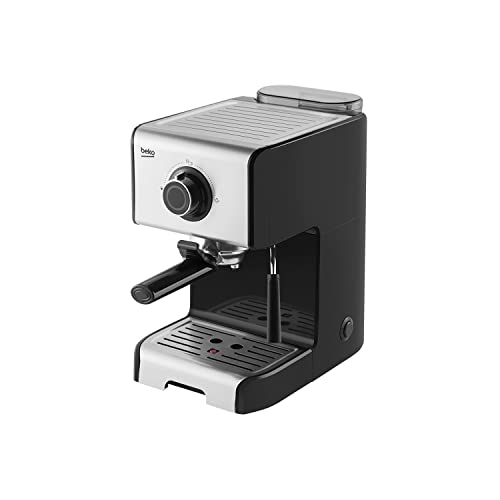Coffee and Espresso Machines
Espresso machines utilize pressure to force water into finely ground and tamped beans. They produce a rich, tasty brew.
Experts from the Good Housekeeping Institute recommend models that brew at a minimum pressure of 9 bars in order to get the most efficient extraction. Beware of manufacturers that claim to use more pressure than is necessary.
Types
The espresso machine (also known as a coffee or Espresso maker) brews coffee that is more concentrated, and of better quality, than your usual cafe drinks. It uses an average of nine bars of pressure. These machines have many features, such as temperature and brew-strength control as well as programmable brewing, and a variety of sizes of drinks. Some machines can have steam wands with either manual or automatic settings for creating texturized milk to create Latte art. There are three types of latte art of semi-automatic, super-automatic, and automatic. Each espresso machine comes with its own specific level and type of automation.
Semi-automatic espresso machines are the most popular choice for specialty coffee shops. Semi-automatic espresso machines allow baristas to have full control over the brewing process however they are not as user friendly as fully automated or automated machines. To get the most perfect espresso, you have to grind the beans, then fill the portafilter and tamp it down, then adjust the time of extraction.
Automated machines have a built-in mill and measure and measure your grounds and. They automatically disperse the right amount of water to make the espresso, and they often come with a programmable drink size function. They were the most frequent espresso machine type in our lab tests and they provide a great combination of consistency and human control.
Functions
You'll need a reservoir to hold the water you use to make coffee, whether you opt for a steam-driven machine or a pump-driven machine. There's a heating element that heats the water to create the pressure needed to extract the coffee from the grounds.
When the brew lever gets raised, it triggers the water inlet cam that seals the valve that prevents pre-infusion so only hot water that is pressurized to a high pressure flows through the portafilter before being ground into coffee. It takes around 25 minutes for the water to be brewed into espresso.
The hot-water tubing also referred to as the insulated tube, is a tube that runs from the reservoir to the spout at the top of your machine. The resistance heating element warms the water as it passes through the warming plate made of steel and the aluminum tube.
After the spout is turned on the cup, place it under the spout, so that the espresso flows into your drink through the portafilter. The coffee maker is also likely to include a steam wand which you can use to heat and froth milk to make espresso-based drinks such as cappuccino or latte.
Automated machines take the guesswork out of the brewing process. They operate with just one button They can be programmed, and they grind and measure beans for you as well as grind them down. In our Lab tests, they are found to perform best because they are simple to use and don't require an extensive amount of user expertise.
Materials

The inside of an espresso machine is a jungle of copper tubes, stainless steel boilers, and intelligent firmware. While they may appear complicated but their primary function is to convert hot water into finely ground coffee.
When choosing an espresso maker, you should consider the size and space requirements, drink options, energy-saving options, and brewing accuracy. Look for a steam button to activate the steam wand. It can be used to make the latte art and frothing the milk. The front of the machine includes a gauge for pressure that can provide the operating pressure for the boiler and pump. Find an espresso maker that has two needles so that you can observe both the minimum and maximum pressure.
If you're looking to do more than espresso, you should choose a machine that offers different brew sizes, including the ristretto. There are also models with an insulated frothing hopper that lets you enjoy hands-free, hassle-free frothing. You can also switch between various kinds of milk quickly. If you're suffering from hard water, opt for the model that has a built-in softener to prevent the buildup of minerals and keep your espresso tasting fresh.
Certain manufacturers employ PID (proportional integral, integral, digital) thermostat to maintain an exact temperature range for espresso brewing. This feature ensures a consistent, high-quality cup of espresso every time. It also helps save on cost of energy, as the machine only operates when it's necessary.
Maintenance
The maintenance of espresso machines and coffee makers is becoming more crucial as they become more accessible for use at home. The right equipment can make a world of difference in your cup of coffee, but it's only true if your machine is working properly.
Regular maintenance and cleaning needs to include everything from cleaning of the group head, steam wand and water filter to decaling and changing the water filters frequently. If you're making between two and five coffees each day, it is recommended to clean the main parts of your machine once a week. Certain components of the machine require cleaning every two to three weeks, for instance, the water tank and grinder.
In addition, you should backflush your system every week. espressomachines involves locking the portafilter in place and running the brew cycles several times. This allows you to get rid of any coffee grounds or oils left behind. You can also clean the portafilter with brushes and cleaners specifically designed for espresso machines.
Maintaining your coffee and espresso machine correctly will also help it last longer. A lot of professional espresso machines found in offices and cafes cost a lot of money, and it is essential to keep your machine in good shape to ensure it lasts as long as possible.
